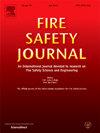An experimental study on the heating and burning of a binary liquid mixture in a pool fire
IF 3.3
3区 工程技术
Q2 ENGINEERING, CIVIL
引用次数: 0
Abstract
The paper presents an experimental study on the transient heating and burning of binary mixtures of cyclohexane and methanol in square burners made of steel and with three different side lengths: 8.0, 10.5 and 15.0 cm. Each burner is 5 cm deep, and the initial fuel height is about 4.6–4.8 cm. Experimental measurements of the transient profiles of burning rates and liquid temperatures (at different depths below the surface) are carried out. Prior to ignition, an upper cyclohexane-rich layer settles above a lower methanol-rich layer. During the initial transient and steady-state periods, the burning is slightly lower than that of pure cyclohexane due to the presence of methanol in the upper layer. Then, the expansion of methanol vapor – forming at the interface between the two layers and reaching the surface – causes the phenomenon of boilover, which is characterized in terms of onset time, peak intensity and duration for different initial mixture compositions. After boilover, depending on the initial amount of methanol, there could be either (i) burning of (almost) pure cyclohexane, (ii) azeotropic burning, or (iii) azeotropic burning followed by the burning of (almost) pure cyclohexane. These results provide more insights into phenomena that are relevant to practical applications in fire safety or industrial fire hazard management, such as tank fires.
二元液体混合物在池火中加热燃烧的实验研究
本文对环己烷和甲醇二元混合物在边长分别为8.0、10.5和15.0 cm的钢制方形燃烧器中瞬态加热和燃烧进行了实验研究。每个燃烧器深5cm,初始燃料高度约4.6-4.8 cm。实验测量了燃烧速率和液体温度(在地表以下不同深度)的瞬态分布。在点火之前,上层富环己烷层位于下层富甲醇层之上。在初始瞬态和稳态阶段,由于上层存在甲醇,燃烧量略低于纯环己烷。然后,甲醇蒸汽的膨胀——在两层之间的界面形成并到达表面——引起了沸腾现象,其特征是不同初始混合物成分的发作时间、峰值强度和持续时间。沸腾后,根据甲醇的初始量,可以是(i)燃烧(几乎)纯环己烷,(ii)共沸燃烧,或(iii)共沸燃烧后燃烧(几乎)纯环己烷。这些结果为消防安全或工业火灾隐患管理(如坦克火灾)的实际应用提供了更多的见解。
本文章由计算机程序翻译,如有差异,请以英文原文为准。
求助全文
约1分钟内获得全文
求助全文
来源期刊

Fire Safety Journal
工程技术-材料科学:综合
CiteScore
5.70
自引率
9.70%
发文量
153
审稿时长
60 days
期刊介绍:
Fire Safety Journal is the leading publication dealing with all aspects of fire safety engineering. Its scope is purposefully wide, as it is deemed important to encourage papers from all sources within this multidisciplinary subject, thus providing a forum for its further development as a distinct engineering discipline. This is an essential step towards gaining a status equal to that enjoyed by the other engineering disciplines.
 求助内容:
求助内容: 应助结果提醒方式:
应助结果提醒方式:


